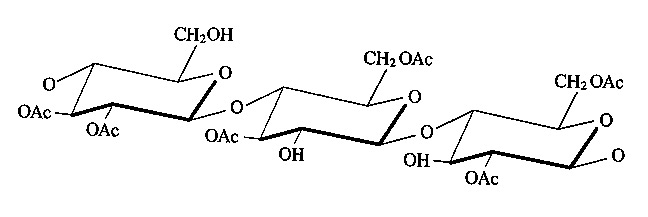
Diacetate
An early form of cellulose acetate base.
The initial 16mm cinema films were made with Cellulose Diacetate, which has an average of 2 out of the possible 3 sites acetylated (see diagram).
It has the characteristic smell of camphor or moth balls. This is the usual method of identifying diacetate if you are unable to unwind the film and inspect the stock markings.

Kodak used diacetate for the base of their new amateur gauge 16mm in 1923.
In the 1930’s, other types of cellulose acetate plastic were introduced: cellulose acetate butyrate (CAB) and mainly used for sheet film, and cellulose acetate propionate (CAP), mostly used for 16 mm motion picture films.
Low flammability was achieved in all of the acetate supports by virtue of the inherent nature of the side groups and by generous additions (10-15% by weight) of fire retardant substances known as plasticizers. Cellulose Diacetate loses its [legacy-smartlink:plasticizer] relatively quickly and therefore becomes brittle with age.
Cellulose Triacetate replaced both Cellulose nitrate and Cellulose Diacetate by 1951.
The National Film and Sound Archive of Australia acknowledges Australia’s Aboriginal and Torres Strait Islander peoples as the Traditional Custodians of the land on which we work and live and gives respect to their Elders both past and present.


